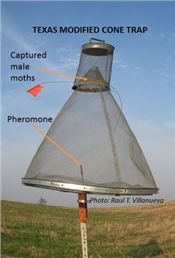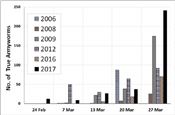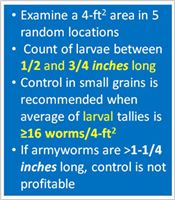|
Beware Of True Armyworms – Mild Winter Provides Conditions For Potential Injuries In Small Grains
DR. RAUL VILLANUEVA
PRINCETON, KY.
The true armyworm (Mythimna unipuncta) is one of the species of armyworms that feeds on small grains in spring in Kentucky. This species is different from fall armyworm (Spodoptera frugiperda). Fall armyworms overwinter in south Texas and Mexico; whereas true armyworms overwinter as partially grown larvae in grasses or small grain fields east of the Rocky Mountains including Kentucky.
Trapping
Captures of male true armyworms have been completed in Kentucky using a modified Texas wire cone trap (Figure 1). This trap has an insect-specific pheromone that attracts male moths. Texas cone traps are also used for corn earworms, beet armyworm, and yellow stripped armyworm. Southwestern corn borer and fall armyworm are trapped using green bucket traps.
After the first generation of armyworms emerge in spring, they need at least 1 week to start laying eggs. This species is very active at night and most of their feeding occurs at this time. Larvae feed first on bottom leaves and then move into the upper leaves. In wheat, injury to lower leaves can pass unnoticed without causing economic losses. However, upper leaf injuries, such as feeding and clipping off heads, can result in yield reduction.
Under the 2017’s mild winter conditions, adult true armyworms were captured earlier than in previous years (February 24, 2017). In the last tally, 241 adults were captured from March 20 to March 27, 2017 in western Kentucky at Princeton. This count was greater than any previous tallies for March (Figure 2). Numbers of individual armyworms captured are not directly related to damage levels in crops. However, moth captures in pheromone traps can help to predict the presence of pests in fields.
Scouting
Given the current situation, scouting is strongly recommended. Look for armyworms on the ground and check for their frass or characteristic black pepper-like droppings. To sample for armyworms, follow the recommendations indicated in Figure 3.
Insecticide usage should be the last resource. If the average number of larvae is above threshold, an insecticide application might be required. Insecticides registered for control of true armyworms are provided on Table 1. ∆
DR. RAUL VILLANUEVA: Assistant Professor, Extension, University of Kentucky

Figure 1. Texas wire cone trap used to capture true armyworms.
Photo: Raul Villanueva, UK

Figure 2. Weekly cumulated numbers of true armyworms captured on a Texas wire cone
pheromone trap in Princeton, KY in 2006, 2008, 2009, 2012, 2016, and 2017.

Figure 3. Sampling protocol for true armyworms in small grains.

Table 1. Insecticides registered, mode of action, rates, and days to harvest
for control of true armyworms in Kentucky.
|
|